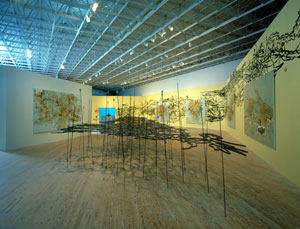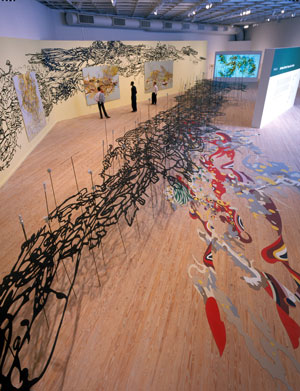A black jagged vinyl-cut drawing launches the Proposition Player exhibition with an expressionist tagging of the sleek metal Contemporary Arts Museum (CAM) building.
This is Matthew Ritchie’s signature style — shifting the borders of traditional media like paint on canvas to the floor, wall, and slippery surface of postmodern buildings.
Organized by Lynn Herbert, Senior Curator at the CAM, Proposition Player (which will travel to MASS MoCA in March 2004) is built loosely around the casino game theme. The exhibition title, which refers to a casino employee who helps initiate games, sets a playful tone for this exhibition that takes over the upstairs gallery floors, walls, and sonic space of the CAM. The scope of this London-born New York-based artist’s first major museum exhibition combines his well-known expressionist canvases with new multi-media work made expressly for this show.
Ritchie is first introduced to viewers through the large wall-panel text as an artist “trying to describe the universe as if he could see everything at once.” This is followed by his quote, “In the information casino, everyone can be a player.” Unfortunately, the result is (to borrow a phrase from another wall label describing one of his works) “a confusing mosaic” of mixed media and botched attempts at interactivity, with neither universe nor game clearly unfolding.
Visitors are meant to take a playing card from the custom-designed deck on the counter near the entrance door. Without a sign or a designated area separating them from the rest of the other museum “take aways,” the cards are easily overlooked.
Once inside the large gallery, you see four large canvases (from 2002-2003) mounted on the far wall. Behind these works is a large black vinyl drawing, The Hierarchy Problem (2003), which covers most of the wall. In front of this busy juxtaposition, you notice The Fine Constant (2003), a large horizontal structure made of black aluminum supported by black poles, bisecting the main room. At first, it is hard to notice that this is a three-dimensional drawing, mounted at roughly chest-height, and similar in line quality and composition to The Hierarchy Problem. You might also miss the faint grey forms speared on the supporting poles. These clay forms are the collaborative result of Houston elementary school children who participated in a workshop with the artist.
Both works were designed using proportions of energy (25%) and matter (75%) as “rules,” à la John Cage . Ritchie references the scientific theory that claims we can only observe 5% of the universe, the rest is “dark energy” and “dark matter.” With this in mind, Ritchie uses the computer to remove 95% of “information” from the compositions in vinyl, steel, and clay.
Emerging from beneath The Hierarchy Problem is a colorful spongy material, The God Impersonator #1 (2003), which covers a large section of the museum floor. This composition is hard to discern over the pattern of the gallery’s knotty wood flooring. Wall text informs you that by repeatedly walking over the material, “the once pristine colors … become muddied and trampled.”
The God Impersonator #1 directs viewers toward The Two-Way Joint (2003), four Duratrans back-lit photographs mounted behind a lenticular lens. This comes off as a gaudy representation of a Ritchie canvas as though seen through a hologram. Behind The Two-Way Joint is a group of delicate vellum drawings, Five of a Kind (2003), and a plexiglass panel representation of Ritchie’s playing card designs.
Among this body of work, Ritchie’s ten canvases stand out most clearly. Their contemporary resonance stems from his skillful painting and stylish Anime palette (blacks, pastel violets, creamy pale blues and raspberry reds) combined with dynamic drawings of squid-like forms and swirling lines. These are overlaid in black marker with mathematical equations and arrows.
At the opposite end of the gallery, a small room contains an installation simply called Proposition Player (2003). From this space emanates a booming audio track comprised of spacey digital samples (classic synthesizer sounds) which animate a video depicting swirling molecular structures, projected onto the far wall. A glossy white table in the center of the room serves as a screen for another projection, one of a craps game table surface. The viewer is supposed to interact with the wall animation by rolling cast resin dice on the craps table. However (during three separate visits) the dice were missing, puzzling visitors who are told by the accompanying wall text that “by participating in the game, viewers have a chance to determine the artist’s universe.”
Also in this room is a panel of “Rules.” The Rules assign meanings to card suits (hearts with love, diamonds with money, spades with conflict, and clubs with growth). More obliquely, the suits are assigned with the five levels of meaning found in Ritchie’s painted and drawn compositions. These levels refer to the “underlying physical structure of the universe,” units of measurement, nucleic acids, “thermodynamic states of entropy, enthalpy, equilibrium, and energy,” and so on, concluded by, “You may already be a winner.”
A brief look at Ritchie’s past presentations may help clarify the themes of this exhibition. In 1996, Ritchie presented The Hard Way, which included paintings (wall and floor) installed in multiple galleries as solo exhibitions (in Galerie Meteo, Paris, Basilico Fine Arts, NYC, and C/O Atle Gerhardsen, Oslo). His invented mythology, along the lines of a Matthew Barney epic narrative, also included an online component (now archived by the Walker Art Center).
Several years later, Ritchie created a three-dimensional installation, Games of Chance and Skill (2001), commissioned by MIT for its fitness center. An interactive web representation of this work uses Macromedia Flash technology to highlight details of drawings on which the installation is based. That same year, Ritchie participated in the groundbreaking exhibition, 010101: Art in Technological Times at SFMOMA, where Internet-based artwork was (finally) recognized by an important U.S. institution. [Note: the Whitney included Net Art in the 2000 Biennial of American Art, but in a much smaller, less successful attempt.] At SFMOMA, Ritchie presented Proposition Player, a narrative Flash animation that introduces characters like Golem and Baby, which appear on the playing card designs at the CAM.
Ritchie’s past work shows the use of artistic media to explore and expose art as a system. With this current exhibition, he continues to employ a postmodern variety of media (canvas, rubber, computer-cut steel, animation programs) in contexts that re-frame their institutionalization (Internet, community, casino, gallery). Hints of this more complex reading emerge from among the romantic watercolors in Five of a Kind. The artist lightly pencils words like entropy, golum, and autopoeisis [sic] (a term associated with the work of biologists Maturana and Varela and sociologist Niklas Luhmann) over underworld creatures.
Ritchie’s so-called universe should not be confused with an attempt to know or explain “the” universe. His voice is more informed than that of a 1950s abstract expressionist who might be tempted to define the World from a sole and privileged perspective. Ritchie and the CAM are clearly more interested in a precisely non-linear approach that deserves a complex response. However, this opportunity is gambled away by the “muddied” presentation. Instead of spending time with this Proposition Player, one is tempted to throw in the cards.
Images courtesy the artist and the Contemporary Arts Museum.
Allison Hunter is an artist, writer, and web designer living in Houston.




